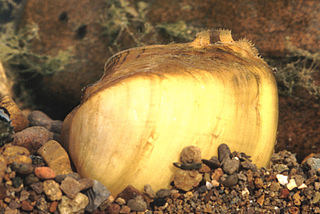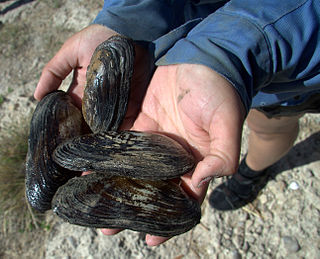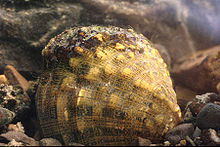
The Unionidae are a family of freshwater mussels, the largest in the order Unionida, the bivalve molluscs sometimes known as river mussels, or simply as unionids.
Alasmidonta atropurpurea, common name Cumberland elktoe, is a species of freshwater mussel, an aquatic bivalve mollusk in the family Unionidae, the river mussels.

Sinanodonta woodiana, the Chinese pond mussel, Eastern Asiatic freshwater clam or swan-mussel, is a species of freshwater mussel, an aquatic bivalve mollusk in the family Unionidae, the river mussels.

Unionida is a monophyletic order of freshwater mussels, aquatic bivalve molluscs. The order includes most of the larger freshwater mussels, including the freshwater pearl mussels. The most common families are the Unionidae and the Margaritiferidae. All have in common a larval stage that is temporarily parasitic on fish, nacreous shells, high in organic matter, that may crack upon drying out, and siphons too short to permit the animal to live deeply buried in sediment.

The fanshell is a species of aquatic bivalve mollusk in the family Unionidae. This clam is native to the United States, where breeding populations remain in only three rivers. It is a federally listed endangered species of the United States.

Elliptio is a genus of medium- to large-sized freshwater mussels, aquatic bivalve mollusks in the family Unionidae, commonly known as the unionids, freshwater mussels or naiads.

Epioblasma is a North American genus of freshwater mussels, aquatic bivalve mollusks in the family Unionidae, the river mussels. Most of the species in this genus have been lost in modern times, and the entire genus is threatened with the possibility of extinction.

Lampsilis is a genus of freshwater mussels, aquatic bivalve mollusks in the family Unionidae, the river mussels. There are over 100 species in the genus.

Lampsilis ovata, or pocketbook mussel, is a species of freshwater mussel, a bivalve mollusk in the family Unionidae, the river mussels. This species is endemic to eastern North America.

Hamiota perovalis, the orangenacre mucket or orange-nacre mucket, is a species of freshwater mussel, an aquatic bivalve mollusk in the family Unionidae, the river mussels.
Lampsilis rafinesqueana, the Neosho mucket or Neosho pearly mussel, is a species of North American freshwater mussel endemic to Arkansas, Oklahoma, Illinois, Missouri and Kansas.

The birdwing pearlymussel is a rare species of freshwater mussel in the family Unionidae, the river mussels. This aquatic bivalve is native to Tennessee and Virginia in the United States. Its range has declined over 90%. It is a federally listed endangered species of the United States.

Popenaias popeii, common name the Texas hornshell, is a species of freshwater mussel, an aquatic bivalve mollusk in the family Unionidae, the river mussels.

Ptychobranchus is a genus of freshwater mussels in the family Unionidae.

Epioblasma triquetra, common name the snuffbox mussel, is a species of freshwater mussel, a mollusk in the family Unionidae. It is native to eastern North America, where it is a listed as an endangered species in both Canada and the United States.

Freshwater molluscs are those members of the Phylum Mollusca which live in freshwater habitats, both lotic such as rivers, streams, canals, springs, and cave streams and lentic such as lakes, ponds, and ditches.
Obovaria arkansasensis, the Ouachita creekshell, is a species of freshwater mussel, an aquatic bivalve mollusc in the family Unionidae, the river mussels. It is endemic to certain rivers and streams in the Ouachita Mountains, Arkansas, and has a complex life history including its larvae being parasitic on a fish host.

Anodonta cataracta, now Pyganodon cataracta, is a species of large freshwater mussel, an aquatic bivalve mollusc in the family Unionidae, the river mussels. Its common name is the eastern floater.

Potamilus fragilis, previously Leptodea fragilis, the fragile papershell, is a species of freshwater mussel, an aquatic bivalve mollusk in the family Unionidae, the river mussels. P. fragilis is one of the fastest-growing unionid species and the most abundant unionid species in Lake Erie. Its light-shelled morphology suggests an adaptation to deep water within lakes.

Ambleminae is a subfamily of freshwater mussel in the family Unionidae. They are found throughout much of eastern North America south to Central America, although fossils are also known from Siberia. Some species have also been introduced to East Asia. They are the most speciose radiation of the Unionidae, with more than 300 species.
















